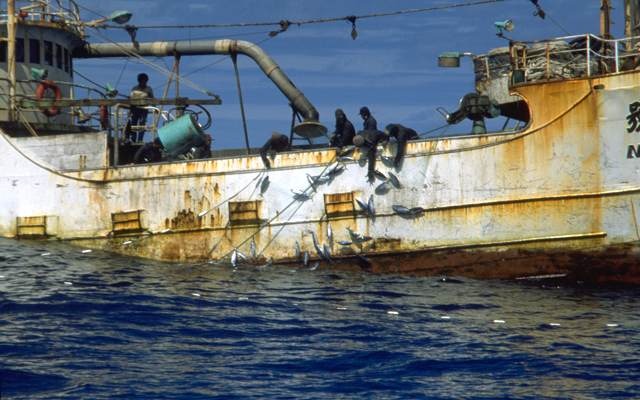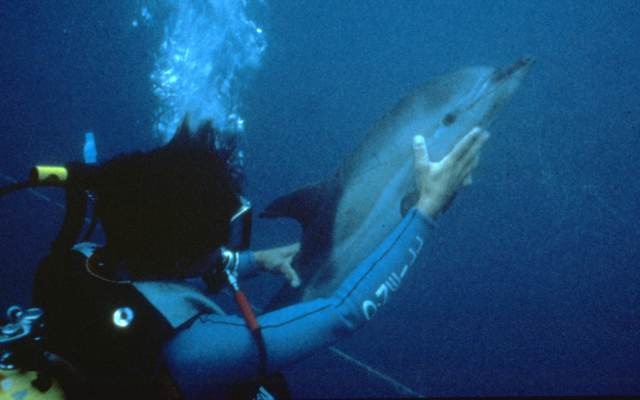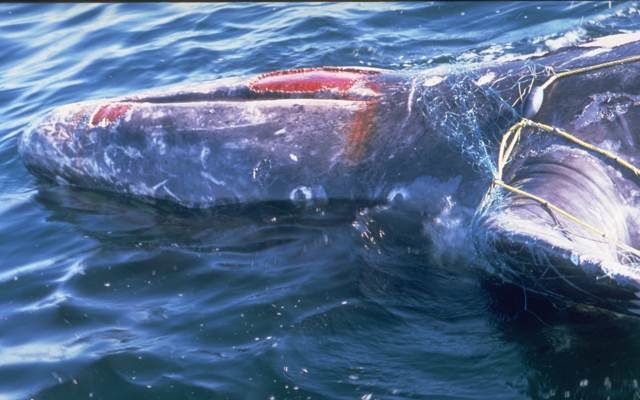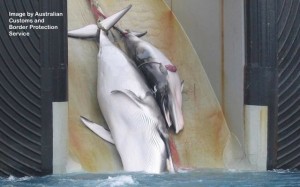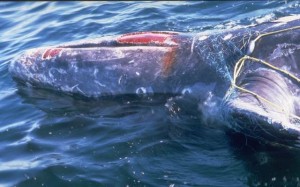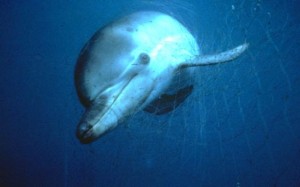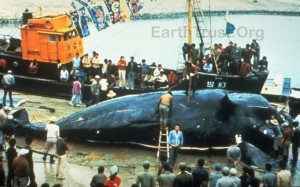We‘ve entered a new era, in which fishing nets are killing a lot more whales than harpoons. And it’s not always an accident.
Fishing nets may determine the whales’ future.
It’s no mystery what happened to the many millions of whales which used to exist in the seas of earth; by their millions, they were shot in the backs with exploding harpoons when rising to the surface to breathe air. They had no chance at all once whalers started using sonar to track them underwater. Wherever a whale surfaced to breathe, the harpoon cannon was waiting. It’s something that neither evolution nor high intelligence could have prepared them for: everyone needs to breathe.
Japan’s “research” blasting adult and baby whales off Australia
Now the remnant whales are mostly the species like minke whales which were not hunted during the last century due to their relatively small size. These whales exist in the hundreds of thousands, but the larger whales have been driven to very low populations, some perhaps too low to rebound, others very near that threshold.
If the great whales are to survive, they must be allowed to reproduce. That will be quite difficult even if we manage to keep the pirate whalers and the “bogus” commercial whalers away from them, because the overfished acidifying and warming seas, increasingly with anoxic “dead” zones, offer less and less food the whales can eat, as humans degrade the ecosystems and take fish to feed billions of pets.
But as the oceans have been strip-mined of their fish resources by overcapitalized and under-monitored fisheries, a new threat has arisen which may cause whale species to continue the slide down to oblivion.
A grey whale killed by a gillnet.
That’s the rise of fishing nets, which entangle and kill whales accidentally, and increasingly are set to entangle whales intentionally, as a legal and even less-humane substitute for harpoons.
The issue of net impacts on whales was first brought to the International Whaling Commission (IWC) in 1990 by EarthTrust’s research on the effect of driftnets on whales and dolphins, leading to the first dedicated IWC scientific meeting on net impacts to whales in La Jolla to discuss the ET research and other information on netting.
Can you see what killed this dolphin? Neither did she. This baby dolphin hangs in an almost-invisible spiderweb of driftnet, where she suffocated only a few feet from the surface in the North Pacific. This image is from an ET expedition to document the bycatch of driftnets. That ET campaign, over years, succeeded in getting driftnet fleets removed from the seas. But with a mis-labeled dolphin’s meat now worth thousands of dollars, the danger of them being secretly deployed is very real.
And it was the ET campaign which publicized the presumed thousands of whales killed annually which the sketchy data indicated. The fight to ban driftnets became, among other things, a fight to save the whales. Driftnets are inherently invisible to cetacean sonar, and large numbers of whales would be wrapped in unbreakable spider webs of monofilament net. Some would still be in the nets when they were pulled, most nets would just wrap around whales and be dragged until the whales died. Pelagic driftnets proved able to depopulate areas of whales in just one or two seasons.
Thus, the ET campaign victory in banning pelagic driftnet fleets from the seas of the world was a huge whale-saving victory, the biggest thing since the whaling moratorium and quite possibly responsible for more whales saved…. not to mention dolphins saved, turtles saved, seabirds, sharks, seals, and hundreds of other species.
But even with those cheap and deadly nets now against international rules, the oceans are hugely overfished, and migrating whales run the gauntlet like puppies on a multi-lane highway. These giant webs are killing off the world’s whales at the same time they are destroying human food resources via overfishing the resources.
But bad as this is, and predictable… it’s inadvertent – most fishermen don’t want whales in their nets, and seek to prevent it. Whales can damage their nets, after all.
Unfortunately, this is changing. In a world that allows hundred-dollar-a-plate whalemeat restaurants but disallows harpooning, nets are increasingly being set exactly in the path of whales to intentionally snag them. Because snagged whales may be legally killed and eaten in many nations.
ET’s pirate whaling expose’s ended the harpooning of whales in Korea, above. But now the whalemeat restaurants in Ulsan are well-supplied by “accidentally netted” whales. There is such a steady flow of such “accidents” that the restaurants always seem to have supplies.
This was originally considered a reasonable compromise – if a whale has died in the nets, or is so injured it can’t be saved and released, why “waste” it?
But these days, with individual whales worth tens of thousands of dollars, it can be worth a lot more to snag a whale than to catch fish. So increasingly, the whalemeat trade is being supplied by this bogus “accidental” take which is anything but accidental.
And nets, by their nature, are even less selective than harpoons. There is no way to keep highly endangered whale species out of nets. Whatever swims into the net is what you snag.
ET and STWI are pushing to close the “net profit” loophole of illegal whale taking via fish nets; and it’ll be a difficult fight because those doing it don’t even acknowledge they’re whaling, nor does the IWC. Like the U.S. tuna industry which killed off millions of dolphins by intentionally targeting them in tuna nets, the industry is based on spinning a fundamental lie.
We feel good about the fact that ET exposes have shut down harpoon ships, and great about the fact that we’ve gotten tens of thousands of miles of driftnets removed from the seas. But it’s hard to feel these as permanent victories as nets are increasingly set to supply a growing luxury restaurant trade.
Nobody needs whalemeat restaurants, nutritionally. They’re a tourist gimmick, a luxury food for the wealthy. Join us in helping to get the nets off the whales. We’ve showed it can be done, but the whale nets are now on the increase again. And the net effect is the same as using harpoons.


